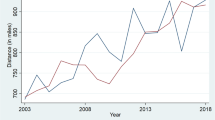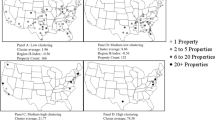Abstract
We study the effect of geographic portfolio diversification of real estate firms on their investment performance before and after the global financial crisis (GFC). In addition to previously used dispersion metrics, we also account for the distance of the properties to the corporate headquarters. We document a notable shift in the non-market performance of real estate companies after the crisis. Pre-GFC, we do not find a difference in non-market performance across equities based on geographic diversification. Post-GFC, equities with high geographic dispersion significantly outperform the market, while firms with concentrated property holdings do not deliver a significant alpha. Increased real estate equity market sophistication and strong institutional presence can explain why this effect is only observed for dispersed small firms, those invested outside gateway metro areas, or companies with low institutional ownership.


Similar content being viewed by others
Notes
Real estate companies have considerable decreased their leverage following the GFC.
At the property level, we exclude properties located outside mainland U.S. – that means properties located in states like Alaska or Hawaii, for example, are not included to enable a reasonable calculation of the average distance between property pairs.
None of the firms exits the sample period once they have entered. This is a standard way of constructing a data sample in asset pricing model.
Alternatively, we also used NCRIEF total return indicator as additional measure for real estate market performance, the results remain robust. However, the beta for NCREIF total return index is significantly negative, which might be caused by the multicollinearity between NCRIEF return, NAREIT return, and stock market return.
We have performed additional robustness for our result of Table 4: (1) There were 41 firms in our sample of 223 firms that were acquired during our sample period. The concern arises that the acquirer may not purchase all the properties, even though SNL keeps the records of the firms and the changes in the headquarter/assets. We rerun Table 4 excluding the 41 firms, and the findings are robust as shown in Appendix Table 10; (2) To address the concern of couple firms driving our findings and causing the results being biased, we winsorize the returns at 95 percentile. The results are still robust as documented in Appendix Table 11; (3) Lastly, we use the adjusted-cost weighted distance measured by is the maximum of the reported book value, the initial cost of the property, and the historical cost of the property, including capital expenditures and tax depreciation. The results are relatively robust, as in Appendix Table 12.
The period between 2007 to 2009 is too short to run a Fama-MacBech regression.
References
Aarland, K., Davis, J. C., Henderson, J. V., & Ono, Y. (2007). Spatial organization of firms: The decision to split production and administration. RAND Journal of Economics, 38, 480–494.
Aggarwal, R. K., & Samwick, A. A. (2003). Why do managers diversify their firms? Agency reconsidered. Journal of Finance, 58, 71–118.
Barinov, A. (2014). Turnover: liquidity or uncertainty? Management Science, 60(10), Pages iv–vi, 2381–2617.
Bernile, G., Kumar, A., & Surlaeman, J. (2015). Home away from home: Geography of information and local investors. Review of Financial Studies, 28, 2009–2049.
Capozza, D. R., & Seguin, P. J. (1999). Focus, transparency and value: The REIT evidence. Real Estate Economics, 27, 587–619.
Cohen, L., Frazzini, A., & Malloy, C. J. (2008). The small world of investing: Board connections and mutual fund returns. Journal of Political Economy, 116, 951–979.
Coval, J. D., & Moskowitz, T. J. (1999). Home bias at home: Local equity preference in domestic portfolios. Journal of Finance, 54, 2045–2073.
Coval, J. D., & Moskowitz, T. J. (2001). The geography of investment: Informed trading and asset prices. Journal of Political Economy, 109, 811–841.
Feng, Z., Pattanapanchai, M., Price, S. M., & Sirmans, C. F. (2019). Geographic diversification in real estate investment trusts. Real Estate Economics. https://doi.org/10.1111/1540-6229.12308.
Garcia, D., & Norli, O. (2012). Geographic dispersion and stock returns. Journal of Financial Economics, 106, 547–565.
Giroud, X. (2013). Proximity and investment: Evidence from plant-level data. Quarterly Journal of Economics, 128, 861–915.
Ghosh, C., & Sun, L. (2014). Agency cost, dividend policy and growth: The special case of REITs. Journal of Real Estate Finance and Economics, 48(4), 660–708.
Hartzell, J. C., Sun, L. B., & Titman, S. (2014). Institutional investors as monitors of corporate diversification decisions: Evidence from real estate investment trusts. Journal of Corporate Finance, 25, 61–72.
Hong, H., Kubik, J. D., & Stein, J. C. (2005). Thy neighbor’s portfolio: Word-of-mouth effects in the holdings and trades of money managers. Journal of Finance, 60, 2801–2824.
Kim, S. and A. Schmidt and K. Wentland. 2017. Analysts, taxes, and information processing costs. Working paper.
Landier, A., Nair, V. B., & Wulf, J. (2009). Trade-offs in staying close: Corporate decision making and geographic dispersion. Review of Financial Studies, 22, 1119–1148.
Lehavy, R., Sloan, R.G. (2008). Investor recognition and stock returns. Review of Accounting Studies, 13, 327–361.
Ling, D. C., A. Naranjo and B. Scheick. 2018. There’s no place like home: Local asset concentration, information asymmetries, and commercial real estate returns. Working paper.
Ling, D. C., Wang, C., & Zhou, T. (2020). Institutional common ownership and firm value: Evidence from real estate investment trusts. Real Estate Economics. https://doi.org/10.1111/1540-6229.12312.
Malloy, C. (2005). The geography of equity analysis. Journal of Finance, 60(2), 719–755.
Van Nieuwerburgh, S. and L. Weldkamp. (2009) Information immobility and the home Bias puzzle. The Journal of Finance, 3
Wang, C. T. Zhou and J. L. Glascock. 2017. Geographic proximity and managerial alignment: Evidence from asset sell-offs by real estate investment trusts. Working paper.
Wulf, J. (2009). Influence and inefficiency in the internal capital market. Journal of Economic Behavior & Organization, 72, 305–321.
Acknowledgements
We thank David Shulman, Charles-Olivier Amédée-Manesme, Bertram Steininger, Alex Moss for helpful comments and suggestions and the seminar participants at Baruch College, Laval University, RWTH Aachen, the 2018 ERES, and the 2019 EFMA meeting in Portugal.
Author information
Authors and Affiliations
Corresponding author
Additional information
Publisher’s Note
Springer Nature remains neutral with regard to jurisdictional claims in published maps and institutional affiliations.
Appendix
Appendix
Rights and permissions
About this article
Cite this article
Milcheva, S., Yildirim, Y. & Zhu, B. Distance to Headquarter and Real Estate Equity Performance. J Real Estate Finan Econ 63, 327–353 (2021). https://doi.org/10.1007/s11146-020-09767-4
Published:
Issue Date:
DOI: https://doi.org/10.1007/s11146-020-09767-4




